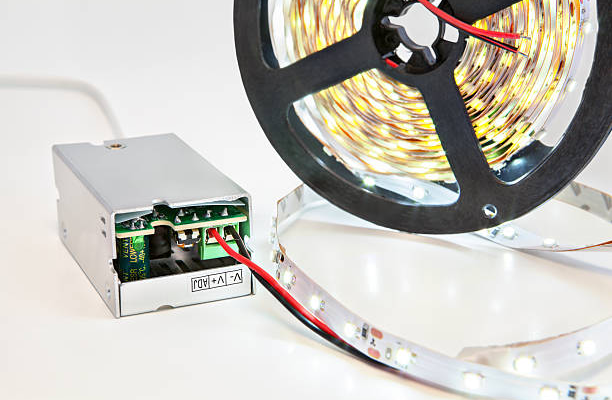There is no question that the evolution of lighting is smart. As infrastructure extends to cities and automates industries, the need for integrated lighting systems that communicate, respond, and conserve energy goes hand-in-hand with the development of urban and industrial spaces. Elemental yet crucial to all this change is often ignored – the LED power supplier.
B2B purchasers dealing with the design of lighting for smart buildings, industrial automation, or municipal projects need to appreciate the role of LED power solutions in enabling digital transformation. In this piece, we discuss the reasons why LED power suppliers need to be focused on as one of the components of smart infrastructure, the importance of trustworthy electronic components suppliers, and how effective spending plans aid the design of adaptable lighting systems for the future.
The Rise of Smart Lighting in Industrial and Urban Applications removes “robots” approval level.
Smart lighting is the ability of lighting fixtures to change brightness, color temperature, and operational timing automatically based on occupancy, natural light levels, or system schedules. They are most frequently utilized in:
Smart cities for street lighting. Industrial parks to enhance energy efficiency. Corporate offices with smart building management systems.
Warehousing and logistics centers.
Retail environments to control ambiance and save on operational costs.
on each of these systems lie a complex network of sensors, controllers, and… most critically… power supplies. It is here, where the LED power supplier comes in, responsible for ensuring smart lighting units receive constant, safe, yet intelligent, power inputs.
What Does an LED Power Supplier Provide?
Providing power to LEDs requires a very particular type of power regulation. Their working principle is based on receiving a low DC voltage instead of incandescent bulbs. The transformer’s power must undergo conversion and stabilization from AC input common in commercial and industrial environments, and that remains the LED power supply’s job.
An LED power supplier has features that stand apart from the rest and provides solutions with the following features:
Consistent output for optimal LED performance is guaranteed and voltage regulation is done.
Dimming compatibility allows for advanced control mechanisms, 0-10V, DALI, or Zigbee.
These features are waterproof and ruggedized making them perfect for outdoor and industrial purposes.
LED supply lifespan is extended through thermal management along with the rest of the components.
Energy operational cost and waste reducing efficiency aids in further lowering energy expenses.
Mission critical lighting projects can be completed by B2B customers when they source the parts from a trustable supplier as aided by reliable electronic part suppliers.
Re-seasoned LED power supplies make smart infrastructure possible.
Smart ecosystems consist of devices made for data, instruction sending and information processing. These systems include LED lighting which seems simple but is necessary for visibility within the infrastructure. This is what enables smart infrastructure.
Hand in hand with LED power supplies, smart infrastructure would be impossible.
The network for smart lighting relies on seamless interaction between systems and control units devices referred to as end devices. Schedules set up for dimming, lights, and even safety features can result in failure and cause use of power to stop delivery. When self powered, an LED power supply configured optimally allows for seamless data and power transmission for functioning devoid of interferences.
Scalability
Every solution must be scalable, from simply illuminating a small smart city district industrial warehouse to a more complex smart city district. Integrators can build scalable systems using modular LED power supplies without major alterations to the architecture. With respect to planning for long-term growth, this degree of flexibility is invaluable.
Integration with IoT
Currently, LED power supplies are incorporating interfaces or IoT system connectivity. To unlock remote monitoring of the system’s health, predictive maintenance, and dynamic lighting schedules, operational efficiency is enhanced while manual interventions are greatly reduced.
Sustainability
Saving energy is more than just a fad—it’s essential for business. Smart lighting driven by advanced supplies optimally uses electricity and therefore, helps reduce operational expenses. Additionally, as affordability increases, meeting corporate sustainability objectives, compliance, and policy mandates becomes easier.
Precision in many of these scenarios is achieved through collaboration between a skilled LED power supplier and a multi-faceted electronic parts supplier. The result is a robust and flexible solution for enduring challenges.
What Should You Assess When Choosing A Supplier For LED Power?
The correct supplier can significantly enhance system performance, reduce installation duration, and lower maintenance costs. B2B clients should consider the following criteria when evaluating LED power suppliers:
Technical Details Check bounds of voltage levels, current output, efficiency, and other relevant industry compliances like CE, RoHS, UL. These factors determine not only functionality but also the legal market installation value in various global markets.
Environmental Hardiness
Smart infrastructure does not always come encased in climate-controlled buildings. Outdoor lighting and industrial setups often coexist within temperatures that fluctuate with dust and moisture exposure. The LED power supplier should provide IP rated ruggedized units specifically designed to withstand these environmental factors.
Interaction With Other System Integration
Make certain that the power supplies are compatible with advanced control interfaces such as DALI , KNX, or Zigbee Pro. This is essential not only for infrastructure adaptability but also for remote access or autonomous adjustment.
Product Lifecycle Maintenance
B2B installations tend to have high component volume requirements with synchronized lifecycles. A vendor with lifecycle documentation, controlled parts compatibility, and firmware upgrade support can help avert these challenges.
Regional and International Logistics
An efficient electronic parts supplier is crucial for the delivery of LED power components and ensuring that they are region certified and accompanied by the necessary technical documentation. They stand between the manufacturers and the end users and help in meeting the timelines set for projects.
Trusted electronic parts suppliers in collaboration with advanced led power suppliers have the ability to meet the performance and commercial needs of the complete system solutions customers.
Emerging Trends of LED Power Supply Market
The LED power supply industry is rapidly advancing to keep up with the pace of advancements in lighting systems. Some important trends to watch for emerging B2B purchasers are:
Smart Construction: Power supplies with Bluetooth, Wi-Fi, or mesh networking capabilities facilitate their inclusion into smart networks, providing effortless access.
Miniaturization: The size of power components mirrors the size of the luminaires they service, which is extremely compact.
Increased energy Standards: Stricter compliance with efficiency level requirements is becoming a differentiating factor.
Predictive Maintenance: Systems that monitor the unit’s condition give real-time diagnostics and schedule services which can be executed at the appointed time.
Universal Input Voltage: Eliminating the need for regional variations enables support for a larger portion of world markets.
These suppliers guarantee that their concepts are the most advanced in the market and therefore helps in reinforcing the importance of using their products.
And as previously mentioned, a LED power supply is a sophisticated component that serves a role far greater than just an electrical machine—it’s a power management system within a smart lighting communication network that is multi-functional and reactive. They enable everything from national level integrations to commercial level systems; these components directly lower operational costs, reduce energy waste, and allow for digital governance.
B2B clients that want to enable smart lighting systems that are reliable and high-performing can partner with specialized suppliers of led power supplies and expert suppliers of other electronic components and custom make their solutions.
If your company is in the process of creating or enhancing their lighting system, make LED power sourcing one of the first decisions you make. In modern day smart lighting applications, power serves as more than just an input—it is the main powerhouse of intelligence.




